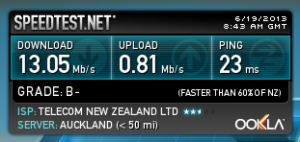Today’s announcement that the English Premier League will only be available over the internet has caused a little angst among people worried about their broadband speed. Because many folk aren’t getting the best out of the broadband connection they have, here’s the best single thing you can do to improve things at your place*. Your experience may vary of course.
What is a master filter or splitter?
It’s a piece of equipment that separates your broadband signal from the other things that run over your copper landline phone line, like phone(s), MySKy or burglar alarms. Mine sits somewhere under my house, I haven’t laid eyes on it since it was installed.
Why should I get one?
Separating the signal means your broadband has its own dedicated line and interference from all those other things is dramatically reduced, so you can go faster, have a more stable connection etc.
 |
| Your master filter at work – image nicked from here. |
But sir, my house wiring has not skipped a beat for the last 40 years etc.
Most people’s houses were built before broadband internet connections shared phone lines, and their home wiring was not designed to accommodate these new fangled thingos comfortably. A master filter or splitter is the most cost effective way to make sure you’re getting the most out of your existing broadband connection.
How much does it cost and how do I get one?
I paid $150, and I understand it still costs about the same, give or take. It’s a one-off fee. You get one by calling your internet service provider, and they’ll arrange for Chorus to come and install it, whoever your ISP is. Some electricians and cabling specialists can do it too, have a Google.
My own experience
I live in Auckland’s East Coast Bays, a few hundred metres from our local broadband cabinet**. When I first had a splitter installed back in 2008, my connection went from 2 Megabits Per Second to 6MBPs. When our cabinet went live, that went up again to 8-10MBPs, and when Chorus came out to do some other work in the area, noticed our wires were corroded and replaced them, that went up to 12-14MBPs. Ours is nothing special, a bog standard connection, I’m on a standard full speed retail broadband plan.
I can download iTunes music, watch YouTube, use Apple TV and surf the internet on my desktop machine, iPad or our work laptops over WiFi just fine, we’re very happy with the speed and reliability. Here’s a speed test I just did, in the mid evening, peak time for internet use. I imagine if I sign up for this Premier League carry on, that will work great too.
What else?
I have an ADSL2+ enabled router (or modem), which means I can go as fast as I can on standard modern broadband. It cost about $120, ring up your ISP if you’re not sure what yours is, they’ll tell you. Most modems or routers ISPs supply these days are ADSL2+, it’s in your ISP’s interests that you’re a happy customer.
Don’t take my word for it
Here’s a fairly typical experience – Helen Twose of the Herald increased her speed by 30%, and there’s more here. Geekzone is full of examples like this, I’ve found Geekzone an extremely helpful place to find information and ask for advice.
I want to go faster
Fibre and UFB is coming. And it’ll be great, but it’s a few years away for many. A master filter or splitter is not a silver bullet to Korean-internet-cafe-speeds, but a sensible way to maximise what you have now in a reasonably economic fashion. If you care about your home internet connection, it’s worth investigating.
* This is meant to be a plain language version of Steve Biddle’s excellent and comprehensive post on the same subject. If you’re more technical than me (that’s most of you), go there, you’ll learn something.
** You can check your own situation ADSL2+ or fibre wise on Chorus’ map.

Leave a Reply